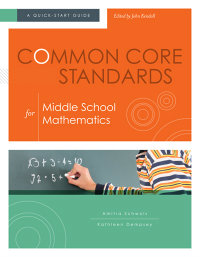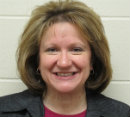Making Sense of CCSS Math
Common Core Standards For Middle School Mathematics: A Quick-Start Guide
By Amitra Schwols and Kathleen Dempsey (Series Editor: John Kendall)
(ASCD and McREL, 2013 – Learn more)
The implementation of the Common Core State Standards is a historical event in education, and classroom teachers are looking for assistance as they strive to fully grasp the standards and their implications for student learning and teaching.
This book is one of the best resources I have encountered as a tool for teachers as they seek to implement these educational changes in their mathematics classrooms. It can and should be viewed as a handbook that every classroom teacher should have as a “go-to” reference on their desk!

The authors offer a thorough explanation of the meaning of the individual content standards and point out the major changes in these areas from former standards. The book then looks at how the content of each of the domains relates to the Mathematical Practice standards and each practice standard is explained in the context of the domain for that grade level.
Additionally, the book offers an overview of each cluster and how it relates to the other standards within and across the various grade levels. Teachers are able to clearly see the mathematical progressions of each domain, and it is very easy to discern how student learning progresses through the various grade levels.
This big-picture perspective is particularly important as teachers begin to implement these new standards. In the first years of CCSS implementation, students in our grades 6-8 classrooms will be essentially starting these new standards in the middle of their education. Therefore, gaps in understanding are almost certain to occur for many students. Using this book as a guide, teachers will be better able to follow the Common Core’s progression of student understanding for each concept, and this will help us identify any gaps in student comprehension. (Read the intro & Chapter 1 here.)
Bonus: Help with instructional planning
As if this book needed further recommendation, the authors offer a chapter entitled “Guidance for Instructional Planning” which supports teachers as they create practical, engaging, standards based lessons incorporating effective instructional strategies explored in the very popular book, Classroom Instruction That Works, 2nd Edition (Dean, Hubblee, Pitler, & Stone, 2012). Teachers learn in this chapter how to design lessons incorporating these new standards while implementing the most effective instructional strategies possible. The authors include three sample mathematics lesson — one for sixth grade, one for seventh grade, and one for eighth grade — using one of the critical conceptual areas of instruction for each grade.
I highly recommend this book. Classroom teachers are desperately searching for guides to help them transition to these new standards, and this book delivers an easy-to-understand explanation of the concepts, progressions, and effective lesson development. Teachers will repeatedly refer to this guide throughout these first several years of Common Core implementation. It is money well spent and would make an excellent resource for individual teachers, math departments, and professional learning communities.
Read another MiddleWeb review of this book by math teacher Rebecca Anderson.
Kathy Felt teaches 8th grade mathematics and Algebra and chairs the math department at Sherrard Junior/Senior High School in Sherrard, IL. She also teaches Elementary and Junior High Math Methods at Western Illinois University-QC and is a member of the Illinois Educator Leader Cadre working with the CCSS assessment group PARCC. Kathy is on the Illinois Mathematical Model Curriculum writing team and last year was named a Master Teacher by The Rock Island Argus/Moline Dispatch. She is married and has three college-aged children.































Thanks, Kathy, for sharing this. I see this transition as a positive one for math education, but I feel inadequately prepared for the shift. I can’t wait to read this book!
You are not alone, Cossondra! The implementation of the CCSS is a really good thing–but such a monumental change. The best thing you can do, I believe, is read quality sources like this book to help you fully understand the content standards, the practice standards, the progressions, and the implications for our teaching. Good luck and remember that we are all in this together (well most states, anyway)!